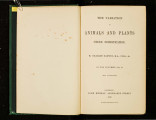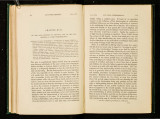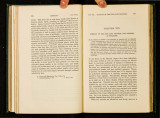| OCR Text |
Show 366 PROVISIONAL HYPOTHESIS CHAP. xxvn. quagga and Lord Morton's mare, affecting the ovarinm of the female, so that tho ovules and offspring subsequently produced by her when impregnated by other males are plainly affected and hybridisod by the first male. JJevelopment.-The fertilised germ reaches maturity by a vast number of changes: these are either slight and slowly effected, as when the child grows into the man, or are great and sudden, as with the metamorphoses of most insects. Between these extremes we have, even within the same class, every gradation: thus, as Sir J. Lubbock has shown/3 there is an Ephomcrous insect which moults above twenty times, undergoing each time a slight but decided change of structure; and these changes, as he further remarks, pTobably reveal to us the normal stages of development which aTe concealed and hurried through, or suppressed, in most other insects. In orclinaTy metamorphoses, the parts and oTgans appear to become changed into the corresponding parts in the next stage of development ; but there is another foTm of development, which has been called by PTofessor Owen metagenesis. In this case " the new parts are " not moulded upon the inner surface of the old ones. The "plastic force has changed its course of operation. The outer "case, and all that gave form and characteT to the precedent " individual, perish and are cast off; they are not changed into " the corresponrung parts of the new individual. These are due "to a new and distinct developmental process," &c.14 Metamorphosis, however, graduates so insensibly into metagen~sis, that the two processes cannot be distinctly separated. FoT instance, in the last change which CirTipedes undeTgo, the alimentary canal and some otheT oTgans are moulded on pTe-existing parts; but the eyes of the old and the young animal are developed in entirely different paTts of the body; the tjps of the mature limbs are formed within the larval limbs, and may be said to be metamorphosed from them; but their basal portions and the whole thorax are developed in a plane actually at Tight angles to the limbs and thoTax of the larva; and this l:l ' Transact. Linn. Soc.,' vol. xxiv., 1863, p. 62. 14 ' Parthenogenesis,' 1849, pp. 25- 26. Prof. Huxley has some excellent remarks (' 1\fedical Times,' 1856, p. 637) on this subject, in reference to the development of star-fishes, and shows how cmiously metamorphosis graduates into gemmation or zoid-formation, which is in fact the same as metn.genesis. CHAP. XXVII. OF PANGENESIS. 367 may be called metagenesis. Th!=l metagenetic process is carried to an extTeme degree in the development of some EchinodeTms, for the animal in the second stage of development is formed almost like a bud within the animal of the first stage, the latter being then cast off like an old vestment, yet sometimes still maintaining for a shoTt period an independent vitality.15 If, instead of a single individual, several were to be thus developed metagenetically within a pre-existing form, the process ·would be called one of alternate generation. The young thus developed may either closely resemble the encasing parentform, as with the larvre of Cecidomyia, or may differ to an astonishing degree, as with many parasitic worms and with jelly-fishes ; but this does not make any essential difference in the process, any more than the greatness or abruptness of the change in the metamorphoses of insects. The whole question of development is of great importance for our present subject. When an organ, the eye for instance, is metagenetically formed in a part of the body where during the previous stage of development no eye existed, 've must look at it as a new and independent growth. The absolute independence of new and old structures, which correspond in structure and function, is still more obvious when several individuals are formed within a previous encasing form, as in the cases of alternate generation. The same important principle probably comes largely into play even in the case of continuous growth, as we shall see when we consider the inheritance of modifications at corresponding ages. We are led to the same conclusion, namely, the independence of parts successively developed, by another and quite distinct group of facts. It is well known that many animals belonging to the same class, and therefore not differing widely from each other, pass through an extremely different course of d~velopment. Thus certain beetles, not in any way remarkably different from others of the same order, undergo what has been called a hyper-metamorphosis-that is, they pass throuo·h an early stage whol1y different from the ordinary grub-like larva. In the same sub-order of crabs, namely, the lVIacroura, as Fritz 15 Prof. J. Reay Greene, in Gunther's ' Record of Zoolog. Lit.,' 1865, p. 625. |


































































































































































































































































